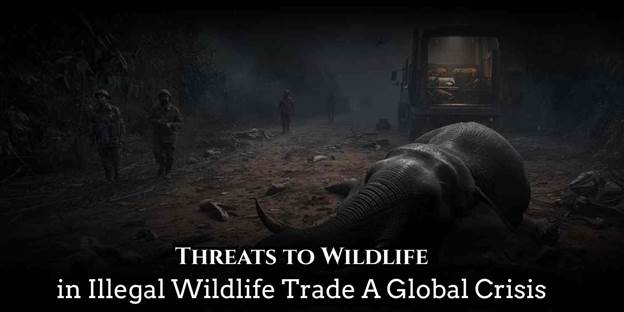Among the most pressing threats to wildlife, poaching and illegal wildlife trade stand as one of the most alarming global challenges. Every year, thousands of animals are killed or captured for profit, fueling a multi-billion-dollar black market. These brutal acts don’t just harm individual species they destroy entire ecosystems. From elephants hunted for ivory to pangolins trafficked for their scales, poaching represents one of the most destructive threats to wildlife and biodiversity.
Table of Contents
In this article, we will explore the origins of this crisis, its ecological and economic consequences, real-world examples of endangered species, and the global efforts to stop this tragedy. Understanding the scope and seriousness of poaching is essential if humanity hopes to overcome these growing and restore balance to nature.

Poaching and Illegal Wildlife Trade: The Dark Side of Human Greed
1. Threats to Wildlife: Understanding Poaching and Illegal Trade (Definition & Overview)
Poaching refers to the unlawful hunting or capturing of wild animals, while the illegal wildlife trade involves selling or transporting these animals or their parts for financial gain. Together, they have become among the most destructive species worldwide. The trade includes ivory, rhino horns, tiger skins, and exotic pets all driven by human greed and demand. Valued at more than $20 billion annually, it ranks among the world’s most profitable illegal industries. These acts endanger species, fuel organized crime, and destabilize ecosystems, making them one of the gravest threats to wildlife on Earth.
2. Historical Background: The Origins of Wildlife Exploitation
The roots of threats to wildlife through poaching date back centuries when animals were hunted for food, trophies, and trade. However, the problem escalated during the industrial and colonial eras when mass hunting became a symbol of power and prestige. In the 20th century, technological advances in transportation and globalization transformed small-scale hunting into organized international trafficking. Although the Convention on International Trade in Endangered Species (CITES) was introduced in 1975, weak enforcement has allowed poaching to persist. This historical backdrop reveals how ancient practices evolved into modern threats to wildlife that continue to devastate biodiversity.
3. Ecological Consequences of Poaching (Environmental Impact)
The environmental damage caused by poaching is one of the most catastrophic threats to wildlife today. Every animal removed from nature triggers a chain reaction affecting the balance of ecosystems.
Key impacts include:
• Biodiversity loss: The extinction of keystone species disrupts food chains.
• Ecosystem imbalance: Predator-prey relationships collapse, leading to overpopulation or scarcity.
• Habitat degradation: Removing animals affects vegetation and soil health.
• Climate impact: Forest and savanna destruction worsen carbon emissions.
These environmental disruptions highlight how poaching contributes to larger and planetary health, threatening both animals and humans.
4. Economic and Social Costs of the Wildlife Trade
Beyond environmental harm, the illegal wildlife trade creates severe economic and social threats to wildlife protection efforts.
Major consequences include:
• Loss of tourism income: Countries like Kenya and Thailand lose millions in ecotourism revenue.
• Funding crime networks: Wildlife trafficking supports global criminal enterprises.
• Community suffering: Indigenous groups lose access to vital resources.
According to the UN, wildlife trafficking is now one of the top transnational crimes. This proves that economic greed and corruption magnify existing threats to wildlife, turning conservation into a battle against organized crime.
5. Real-World Examples: Endangered Species on the Brink
Real examples show the devastating scale of threats to wildlife caused by poaching:
• African Elephants: Hunted for ivory, populations have dropped by more than 60%.
• Rhinoceroses: Targeted for horns used in medicine and ornaments, only a few thousand survive.
• Tigers: Less than 4,000 remain due to illegal hunting for skins and bones.
• Pangolins: The world’s most trafficked mammal, killed for meat and scales.
• Sea Turtles: Eggs and shells sold in black markets, threatening marine ecosystems.
Each example represents a tragic consequence of unchecked, showing how human greed erodes Earth’s natural diversity.

6. Global Efforts to Combat Poaching and Illegal Trade
The fight against threats to wildlife has inspired global collaboration.
Key initiatives include:
• Stronger legislation: CITES enforcement and national bans on animal trade.
• Technological innovation: Drones, satellite tracking, and DNA databases help catch poachers.
• Community-based conservation: Empowering locals to protect wildlife through sustainable tourism.
• Education campaigns: NGOs like WWF and TRAFFIC raise awareness worldwide.
• International cooperation: Countries unite to share intelligence and enforce trade bans.
These actions demonstrate hope in combating threats to wildlife, proving that global unity can overcome even the most complex challenges.
7. Persistent Barriers in Ending Wildlife Crime
Despite progress, major challenges continue to strengthen threats to wildlife across continents.
These include:
• Corruption: Bribery within agencies weakens enforcement.
• High consumer demand: Traditional medicine and luxury markets still thrive.
• Insufficient resources: Vast habitats make monitoring difficult.
• Lack of education: Many communities remain unaware of the issue.
Addressing these barriers requires international collaboration and strict accountability to dismantle systems that allow threats to wildlife to persist.
8. The Road Ahead: A Future Without Poaching
The future depends on how humanity responds to today’s threats to wildlife. By promoting sustainable living, ethical consumption, and conservation funding, we can end poaching and rebuild ecosystems. Global technology, awareness, and enforcement create hope for species recovery. Each person’s choice refusing ivory, supporting eco-tourism, or volunteering in conservation can weaken the demand chain. Together, we can transform threats to wildlife into opportunities for renewal and preservation.
Conclusion
Threats to wildlife caused by poaching and illegal trade are among the most severe global crises of our time. They threaten biodiversity, destabilize ecosystems, and weaken economies. The solution lies in global awareness, strong laws, and community empowerment. Every effort counts whether supporting conservation groups or educating others. Together, humanity can defeat these threats to wildlife and ensure a thriving planet for generations to come. Learn more, act consciously, and be part of the mission to protect Earth’s incredible diversity.